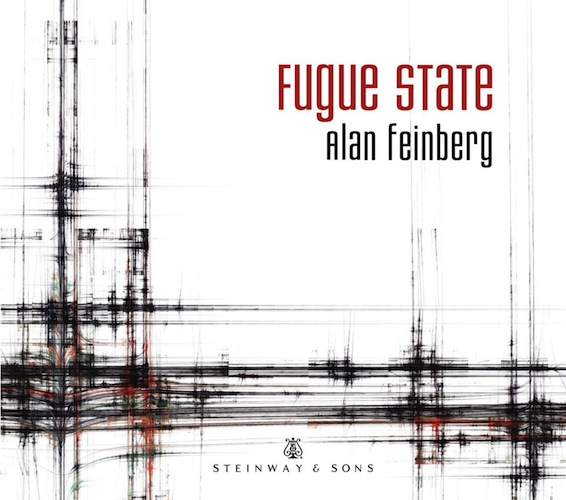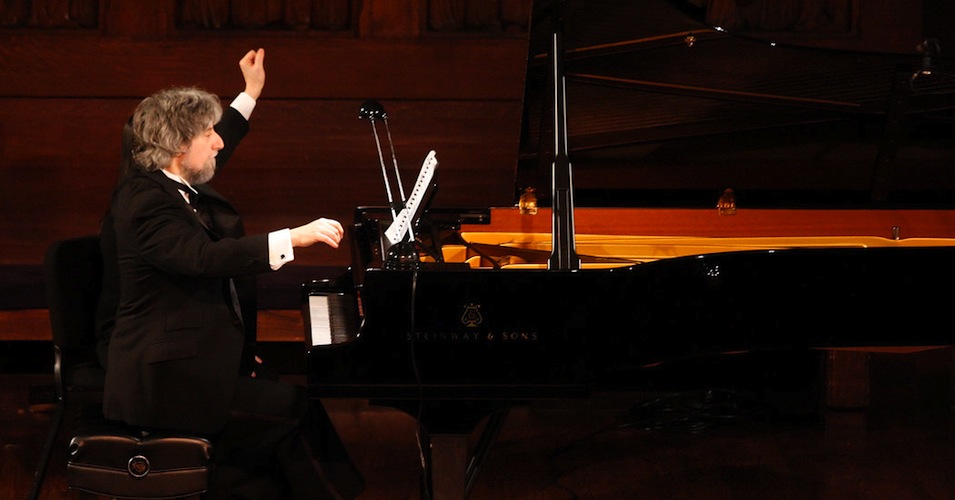
Alan Feinberg, pianist: “Fugue State”

Alan Feinberg is one of those increasingly rare classical pianists who have managed to create an international career without the springboard of a well-publicized competition win. (No knock on competition winners who play like artists—see here. )
Alan Feinberg came to my attention some years back when he recorded a series of four CDs for Argo, one of which included a spellbinding performance of a Fauré “Après un Rêve” transcription by Percy Grainger. Feinberg’s approach was larger than life. Or, perhaps it was more that Grainger’s “transcription” left Fauré’s pensive little art song in the dust of a major construction project.
Feinberg’s playing was electrifyingly dynamic, and his rolled chords were a wonder to behold. Back in the day, I used to carry that CD around at audio shows, asking exhibitors to play it as a respite from, erm, “jazz” and pop female vocals. Many were impressed! That particular CD was The American Virtuoso, Argo 436121; out of print and not very likely to return. Easy to find on eBay or Amazon, though. (NB re: Grainger’s being among the “Americans”: During WWI, Grainger emigrated to the US, and became a citizen.)
That experience left me rather unprepared for Feinberg’s first Steinway & Sons CD, the small-scale (to the point of virtual chastity) Basically Bull, a program of music written in the early 1600s for the charmingly-named early keyboard instrument the virginals. “Virginals” being a paradoxical plural on the order of “scissors” or “pants.” Virginals have a softer tone than the harpsichord—vox virginalis (the voice of a young girl) might be the origin of the instrument’s name.
I think that it’s fair to say that my Stereophile magazine review of Basically Bull (here) was a total rave. I wrapped up by assuring: “Even if the last solo-piano recording you really enjoyed was George Winston’s December, I think you’ll love Basically Bull. Highly recommended.”
So now we have Feinberg’s follow-up, Fugue State. CD Steinway 30034; 24/96 downloads from Pro Studio Masters.

Photo courtesy Alan Feinberg.
Fugue State is a carefully selected program of fugues from two centuries of the High Baroque. Chronologically, the composers range from Froberger (b. 1616) through Buxtehude (b. 1637) and Alessandro Scarlatti (b. 1660), to J.S. Bach, Domenico Scarlatti, and Handel; all of whom were born in the year 1685.
However, Fugue State’s program is not chronological. It begins and ends with the sprawling three- and six-part “ricercars” that begin and end Bach’s The Musical Offering (BWV 1079). “Ricercar” is a formal term that encompasses several compositional techniques predating the fugue; but the form continued as a special case of fugues. (The Musical Offering is one of the few Bach masterpieces that I think are fair to call “under-appreciated.”) Other pieces from Bach and from the other composers make up Fugue State’s generous playing time of 64 minutes.
Along the way, there is enough variation in tempo, mood, voicing, and ornament that there is never a risk that the listener will feel trapped in a clothing factory full of sewing machines that are running at full tilt. While it is true that “fugue state” is an out-of-date mental-health diagnostic term, there is no craziness in this program. The Baroque era was the height, and the end-game, of Christian Rationalism. Bach wrote music along disciplined rational lines, to justify God’s ways to man. And by the time of Bach’s death (1750), that was already out of fashion.
Back to the CD in question. By the time the theme of The Musical Offering’s three-part ricercar has been heard (Track 1), Alan Feinberg has compellingly laid down his marker.

Actually, the shadings of dynamics and the suppleness of the phrasing of the first five notes are all you really need to hear.
There is the same fastidious elegance in keyboard technique that made Basically Bull so captivating. But, there is also a depth of conception to the later works that makes them closer to the spirit of Beethoven than to Bull.
Upon Fugue State’s release, Feinberg noted, “In the end, I think that the performer’s task is to strive to harness the same spiritual, personal, intellectual, and technical concerns that the composer has mustered, in order to re-create or re-imagine these past works for the present.”
To which I would add that neither pianists nor audiences today plausibly can pretend that they had never heard the music of Beethoven, or of all the composers who came later. I think this not so much a case of, we have to update Bach, because we are so much smarter than he. Rather, I think the case is, we can’t un-hear Beethoven, so we are going to perceive, in the work of earlier composers, the beginnings of the paths that lead to Beethoven’s piano music. The earlier composers knew not where their music would lead–had they known, they most likely would have written the later music. But we know, and I think that must influence how the artists of today play early music.
(Which might suggest that trying to arrive at a definitive recreation of a performance that took place 250 years ago is, at best, a Quixotic quest.)
Feinberg himself is one of the most fervent and successful champions of modern music. He has given more than 200 premieres, including significant works by composers such as John Adams, Milton Babbitt, John Harbison, Mel Powell, Shulamit Ran, Steve Reich, and Charles Wuorinen.
In a wide-ranging telephone conversation with Mr. Feinberg, he mused upon the challenges of interpreting music from a time where many composers and performers wished to protect their techniques and innovations, in order to enhance the value of studying or apprenticing with them. As he says it in his liner notes, a “hidden art,” below the surface of the printed score.
There has been much academic and popular discussion as to whether Bach hid (in plain sight) a memory device for a tuning regimen of his own devising on the title and dedication page of The Well-Tempered Clavier. For more on that, click here.
More directly on point for this recording is that, unlike the Goldberg Variations, which were written for the two-manual harpsichord (and therefore have to be arranged to be played on a single-keyboard piano), the opening and closing Bach fugues were written to be played upon single-manual Silbermann fortepianos, which were one of the earliest ancestors of the modern piano.
Frederick the Great, himself an amateur musician, owned several of Silbermann’s experimental instruments. According to Mr. Feinberg, Bach offered Silbermann constructive criticism and helpful suggestions. So to play at least certain works of Bach on a modern Steinway is not a wrenching dislocation but rather an evolution.
Case in point: when Bach famously improvised a three-part fugue on the lengthy and difficult theme provided to him by Frederick the Great, Bach played upon a Silbermann fortepiano that was then at Frederick’s palace at Potsdam. That improvisation was the origin of The Musical Offering. Background here.

© Erin Baiano for The New York Times.
Mr. Feinberg, by the way, told me that although it doubtless was Frederick who handed Bach the fugue theme, he believes that it was more likely Bach’s son Carl Philipp Emanuel who wrote the theme. It’s a theme that does not play “against itself” very naturally. Perhaps a little inter-generational rivalry. (Whereas, if you play “The First Noël” against itself, but at half speed, it harmonizes beautifully; as Elgar demonstrated.)
Musicologist Charles Rosen reportedly claimed that the Ricercar a 6 from The Musical Offering was the most significant piano composition in history. I am not sure I would go that far. But it’s right up there. While I still think that Neville Marriner’s ASMF chamber version is the best place to start with The Musical Offering as a whole, I can assure that Fugue State is a recording that repays repeated deep auditions.
As for the recorded sound, it is a little different from that of Basically Bull; slightly more distant and reverberant. But that I ascribe to the differing demands of the music, and I think that the recorded sound in its own way is as excellent.
Highly recommended.
# # #


